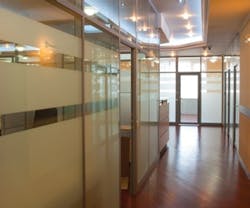A slip, trip, or fall can lead to anything … from a bruised ego to broken bones to legal issues.
"There are many causes of slips, trips, and falls in commercial buildings," says Daniel Wagner, director of facility service programs for ISSA-Worldwide Cleaning Industry Association, "including floors, improper footwear, failure to provide a necessary hazard warning, and lack of training."
While your building’s flooring may not always be at fault, the National Floor Safety Institute (NSFI) says that more than 50 percent of all slips, trips, and falls are caused by flooring issues.
These flooring issues include improper selection of flooring material for a particular space, residue left on a flooring surface, and lack of improper walk-off matting. Poor matting can do more harm than no matting at all by increasing the likelihood of reduced slip resistance of the flooring surface.
A building’s entry areas, restrooms, and cafeterias are common areas for slip, trip, and fall accidents. "Experience indicates that smooth, hard-surface, polished floors with a wet coefficient of friction of less than 0.6 are most often cited in incidents," explains Wagner. "This is especially true where water is frequently present."
Foiling the Fall
Selecting the proper flooring solution for a particular space is one of the best ways to prevent accidents. "Walk-off matting is the best choice for entry areas, and grouted ceramic tile is preferable in restrooms and food areas," says Wagner.
Mats should have a low profile (no more than 0.5 inches higher than the flooring), should be inspected frequently to ensure that there’s no buckling or curling, should be secured to the floor to prevent migration, and shouldn’t contain a build-up of contaminants (grease, water, sand).
Tenants can also be asked to take prevention into their own hands (or feet) by wearing proper footwear for the environment. The National Floor Safety Institute cites shoes or footwear as being the second leading cause of slips, trips, and falls, causing nearly one-quarter of these accidents. "For example, it’s important to wear flat-soled footwear with a proper grip when flooring is wet," Wagner explains. "Further, visitors need to make sure that they don’t get distracted when walking on hard surfaces, and stay aware of liquid on the floor."
In addition, Wagner recommends:
- Choosing cleaning products that don’t leave a residue.
- Performing regular floor audits to ensure that the safety of the flooring isn’t compromised.
- Immediately cleaning up spills and other wet spots (especially during wet weather).
To learn more about flooring products (from mats to scrubbers and cleaning products) that are certified by the National Floor Safety Institute, click here.
After the Accident
While everyone would prefer to avoid slip, trip, and fall accidents, they’re bound to happen. When they do, Wagner urges building owners and facility managers to "file all required and recommended reports, investigate the incident to accurately determine the cause, and take any steps necessary to remediate the potential problem to minimize the likelihood that an accident could happen again."
As a way to reduce risks and demonstrate a commitment to floor safety, building owners and facility managers can adopt and implement a floor safety program that utilizes an independent auditor and document the results.
Kylie Wroblaski ([email protected]) is associate editor for BUILDINGS.
